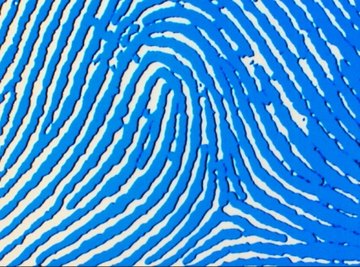
Children enjoy learning new information about science. And if they can "play detective," they might find a unit on fingerprints especially fun. Explain to the class that everyone has a unique fingerprint that can be matched only to them. This is why police gather fingerprints at crime scenes. In fact, fingerprints are so unique that they were even used as signatures in ancient times in Asia.
To Catch a Thief
Before class, pull one student aside and have him or her be the "thief" for this project. You will need to use an ink pad and place the thief's fingerprints on a sheet of paper, fold it up and place it in a cookie jar. Then, during class, explain to students that every person has a unique set of fingerprints. Discuss how this may help police detectives catch criminals. Tell the students that there is in fact a "thief" in class who stole cookies from the cookie jar. To find out who is responsible, have students take their fingerprints and match them to the scene of the "crime." Provide students with ink pads and pieces of paper. Have the class take prints of each finger and thumb on their right hand and place them onto a traced hand shape on a piece of paper. Once every child has been fingerprinted, have the class observe all the prints and compare them to prints found at the crime scene to identify the thief.
Whirl, Loop or Arch
Explain to the fifth-graders that while everyone has a unique set of fingerprints, they can usually be categorized into a certain type of print. The three types are whirled, looped or arched. Provide examples for the children to observe. Instruct the class to take a pencil and on a blank sheet of white paper, rub the pencil over a small area repeatedly until they have created a nice black spot. Next, students should rub their index fingers in the pencil spot until they have coated their fingers. Then have the class carefully lift their fingerprints by applying a small piece of transparent tape to their fingers, then lifting the tape off. Take the print captured on the tape and apply it to a piece of paper. Have students compare their prints to the examples of whirls, arches and loops to determine which type of print they have.
Balloon Fingerprints
For this fingerprint activity, you will need a balloon and a marker for each student. Instruct the children to take a marker and color their fingertips, one at a time. (They will probably color only five fingers for this activity.) Have students carefully place a finger down on the balloon, being careful not to smear the fingerprint. Repeat with the other fingers. Now tell the children to inflate the balloons until the prints become big and clear. They may need to fill the balloon more or take some air out in order to get the prints enlarged but clearly visible. Talk about how sometimes police officers must work with a partial set of fingerprints or smeared prints at a crime scene. Have students identify which of their prints are clearest and discuss ways police officers may use fingerprints to solve crimes.
Lifting Prints
Tell the fifth-graders to run their fingers over their nose, forehead or scalp to collect oil on their fingertips. Then have the children press their fingers onto a clean, plastic cup. Next, have the students carefully dust the surface of the cup with cocoa powder. (Kids might feel a bit more official in the process if they use a clean paintbrush to dust the cup with cocoa powder.) Have the students carefully blow away the excess powder. Students should then take a section of packing tape and carefully apply it to the fingerprint area and then lift it up and reapply it to a piece of white paper. Let the class look closely at their prints with a magnifying glass. (Have the students compare the prints to those in activity 3, on the balloon.)
References
About the Author
Katlyn Joy has been a freelance writer since 1982. She graduated from Southern Illinois University-Edwardsville with a master's degree in writing. While in school she served as graduate assistant editor of "Drumvoices Revue" magazine.
Photo Credits
Jupiterimages/Photos.com/Getty Images
